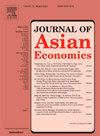Understanding the product structure of exporters: The role of intellectual property protection in export origins
IF 2.9
3区 经济学
Q1 ECONOMICS
引用次数: 0
Abstract
Adjusting the structure of export products is crucial for exporters to respond to export market competition and cost changes. The existing literature has identified firm-level factors, such as productivity, and industry-level factors, such as trade liberalisation, as important determinants of an exporter’s export product structure. However, the institutional quality has received less attention. Using data from Chinese manufacturing exporters from 2000 to 2007, we examine the impact of province-industry level intellectual property protection (IPP) in export origins on product-adding and product-dropping rates of manufacturing exporters from the perspective of institutional quality. We employed an instrumental variable approach to solve the endogeneity problem of the IPP variable. The findings demonstrate that strengthening IPP at origins raises exporters’ product-adding and product-dropping rates, conditional on their production. Exporters can achieve this promotional effect on product-adding and product-dropping rates by transforming towards more downstream production and integrating more vertically along their value chains. Additionally, strengthening IPP can increase the product-adding rate of exporters by encouraging more innovative activities and foreign direct investment absorption and can raise the product-dropping rate by reducing the varieties of imported intermediate goods. In the heterogeneity analysis, we find this product structure effect is insignificant for digital trade exporters. Our findings provide important policy implications for IPP reforms towards export upgrading.
了解出口商的产品结构:知识产权保护在出口原产地中的作用
调整出口产品结构是出口商应对出口市场竞争和成本变化的关键。现有文献已经确定了企业层面的因素,如生产率,和行业层面的因素,如贸易自由化,作为出口商出口产品结构的重要决定因素。然而,制度质量却很少受到重视。本文利用2000 - 2007年中国制造业出口企业的数据,从制度质量的角度考察了出口原产地省部级知识产权保护对制造业出口企业产品增减率的影响。我们采用工具变量的方法来解决IPP变量的内生性问题。研究结果表明,在原产地加强IPP提高了出口商的产品增加和产品减少率,这取决于他们的生产。出口商可以通过向更下游的生产转型,并沿着价值链进行更垂直的整合,来实现对产品增加和产品下降率的促进作用。此外,加强IPP可以通过鼓励更多的创新活动和吸收外国直接投资来提高出口商的产品增加率,并可以通过减少进口中间产品的种类来提高产品下降率。在异质性分析中,我们发现这种产品结构效应对数字贸易出口商不显著。我们的研究结果为IPP出口升级改革提供了重要的政策启示。
本文章由计算机程序翻译,如有差异,请以英文原文为准。
求助全文
约1分钟内获得全文
求助全文
来源期刊

Journal of Asian Economics
ECONOMICS-
CiteScore
4.70
自引率
9.40%
发文量
90
期刊介绍:
The Journal of Asian Economics provides a forum for publication of increasingly growing research in Asian economic studies and a unique forum for continental Asian economic studies with focus on (i) special studies in adaptive innovation paradigms in Asian economic regimes, (ii) studies relative to unique dimensions of Asian economic development paradigm, as they are investigated by researchers, (iii) comparative studies of development paradigms in other developing continents, Latin America and Africa, (iv) the emerging new pattern of comparative advantages between Asian countries and the United States and North America.
 求助内容:
求助内容: 应助结果提醒方式:
应助结果提醒方式:


